|
||||||||||||||||||||||||||||||||
After the colossal disappointment of Star Trek V, someone, somewhere makes the incredibly astute decision to bring back a REAL director, REAL supporting acting talent, a REAL special effects house, and properly bankroll the whole thing. The result is not only a recovery for the Star Trek film franchise, but a picture which breaks out of the cult and is genuinely a good movie for all, including non-Star Trek fans. Star Trek VI, The Undiscovered Country The Federation and the Klingon empire prepare for a peace summit after years of war, but the prospect of harmony with sworn enemies is an alarming one to Admiral Kirk. And when a Klingon ship is attacked and the Enterprise is held accountable, both worlds brace for what may be their final, deadly encounter.
The story is absolutely solid in its blatant parallels to events of the time. Let's not kid ourselves: The Klingons are the Russians, and the explosion on Praxis is Chernobyl (reflecting the times of more than a decade ago). It's that simple. And therein lies the genius of topicality.
ILM deserves the reputation it has earned over the years, and Undiscovered Country is an excellent example. Optical effects and model work are truly state of their art for 1991. Extras There is an Audio Commentary by director Nicholas Meyer and screenwriter Denny Artin Flinn. On the whole it is entertaining, but at times I felt they strayed too far from the scene at hand, often taking time to recount other, less related anecdotes. Also on Disc 1 is a text commentary track by Michael Okuda and Denise Okuda, co-authors of The Star Trek Encyclopedia.
The Star Trek Universe includes material not directly related to the making of the film, including Conversations with Nicholas Meyer (self explanatory). Klingons: Conjuring the Legend is an interesting look at the evolution of the fiction, starting with the original TV series, through the movies, and into the contemporary settings such as The Next Generation, DS9, and Voyager. Federation Operatives is a summary of acting personalities who have appeared multiple times in different Star Trek roles over the years. Penny's Toy Box is a short look at some of the Star Trek props in storage at Paramount. Together Again chronicles, through interviews, the long history that William Shatner and Christopher Plummer have together, going as far back as doing radio shows in Canada together.
Art Imitates Life, The Perils of Peacemaking is a look at the real world politics which Star Trek VI emulated. The A Farewell section includes DeForest Kelly: A Tribute, and Original Cast & Crew Interviews from 1991. Promotional Material includes a pair of Trailers and a 1991 Convention Presentation by Nicholas Meyer
We have to note that like the Star Trek V Collectors edition, none of these extras are 16:9 formatted. This is really odd, as the first four special editions have all their extras 16:9 formatted. Come on Paramount! The Transfer An impromptu search of the internet turned up no results when trying to find the film format in which Star Trek VI was shot. Various movie reviews quote it as a standard 2.35:1 CinemaScope film but this DVD delivers a 2.0:1 frame. Anyone with credible information on this is invited to write in and enlighten us.
We also have to note that the subtitles for the Klingon dialogue are not done with DVD text technology, but rather are burned into the image. A real shame.
In 1991, the limited 70mm release included a Dolby 70mm 6-track soundtrack, and there were several "test prints" which included a Dolby Digital soundtrack (this being the first year Dolby Digital actually started to circulate). Both formats use the same speaker layout, and going from experience, I'd say we are hearing something very close to what was heard over a decade ago at the premier. Characteristic of the first Dolby Digital soundtracks, it tries to impress, but is slightly beyond its ability. To crib a phrase from Amadeus "too much spice... too many notes". It is an exquisite track which in fidelity and spatial artistry stands up to the best, but the extra headroom afforded by the then new audio technology is used seemingly just for the sake of using it as the loud sections are, by any definition, "too loud". This is the only reason for knocking a half point off. Stay tuned for reviews of other Star Trek movies as they are released in special Director's / Collector's Editions.
|
||||||||||||||||||||||||||||||||

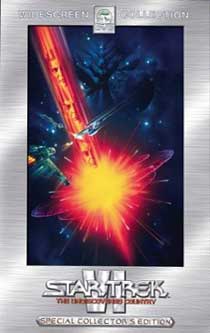
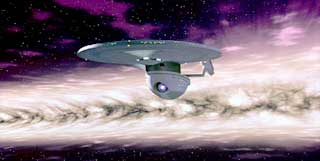 The
Comeback
The
Comeback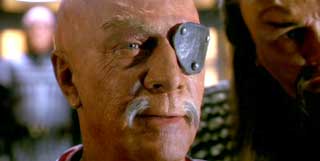 Although
they all came back to sort of "pass the torch" in Star Trek Generations,
it is Undiscovered Country which is officially designated as the final
movie for the original cast. Gratifying indeed it must have been to go
out on such a high note. In the various interviews available, it is no
secret that Star Trek V fell below the bar. I can imagine the
executives at Paramount saying, "Enough is enough" with these guys wanting to
direct their own movies (though Leonard Nimoy wasn't all that bad at it).
It could not possibly be coincidence then that the director of what is
regarded as the "best" Trek, Wrath of Khan, is brought back in, along
with a now advanced (for its day) ILM to do the effects work.
Although
they all came back to sort of "pass the torch" in Star Trek Generations,
it is Undiscovered Country which is officially designated as the final
movie for the original cast. Gratifying indeed it must have been to go
out on such a high note. In the various interviews available, it is no
secret that Star Trek V fell below the bar. I can imagine the
executives at Paramount saying, "Enough is enough" with these guys wanting to
direct their own movies (though Leonard Nimoy wasn't all that bad at it).
It could not possibly be coincidence then that the director of what is
regarded as the "best" Trek, Wrath of Khan, is brought back in, along
with a now advanced (for its day) ILM to do the effects work.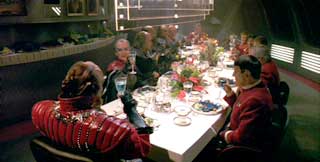 Meyer
proves once again that a very military "nautical" take on the Enterprise
works best. The Kirk character is the most developed we have ever seen
him, while the supporting talent works with the original cast, not against
it. Christopher Plummer is a shoe-in as the war mongering Kligon
captain, while Kim Cattrall pulls off an air of sensuality, despite the
sterility of her character.
Meyer
proves once again that a very military "nautical" take on the Enterprise
works best. The Kirk character is the most developed we have ever seen
him, while the supporting talent works with the original cast, not against
it. Christopher Plummer is a shoe-in as the war mongering Kligon
captain, while Kim Cattrall pulls off an air of sensuality, despite the
sterility of her character.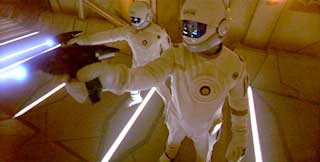 On Disc 2, the
supplemental material is logically sorted into sections.
On Disc 2, the
supplemental material is logically sorted into sections.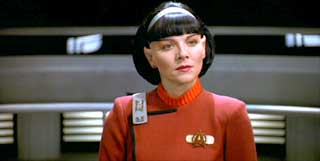 Movie Making
includes all of the behind the scenes type stuff we've come to expect.
There as six featurettes which cover story, casting, and such. There
is virtually nothing about the making of the visual effects and precious
little on the set footage. These six pieces could have been one
concise retrospective of the movie.
Movie Making
includes all of the behind the scenes type stuff we've come to expect.
There as six featurettes which cover story, casting, and such. There
is virtually nothing about the making of the visual effects and precious
little on the set footage. These six pieces could have been one
concise retrospective of the movie.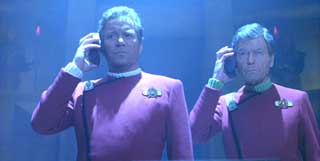 In
the Archives we've got a Production Gallery and various static Storyboards.
In
the Archives we've got a Production Gallery and various static Storyboards.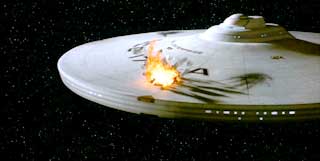 That
artist consideration aside, this is one of the best catalogue releases I've
seen in a while. There is a terrific freedom from pronounced edge
enhancement and/or ringing, and the dynamic range is dialed in just right.
The black threshold appears to be right where it belongs, and there is no
clipping of white. Video noise is kept to a minimum, but we must fault
it on compression: areas of very fine detail "strobe" on the MPEG keyframe (that is, they are fully detailed on the keyframe, lose most of
their detail in subsequent frames, and then get it all back on the next key
frame). Strobing is a normal artifact of the MPEG2 system, but it is
particularly noticeable on this transfer.
That
artist consideration aside, this is one of the best catalogue releases I've
seen in a while. There is a terrific freedom from pronounced edge
enhancement and/or ringing, and the dynamic range is dialed in just right.
The black threshold appears to be right where it belongs, and there is no
clipping of white. Video noise is kept to a minimum, but we must fault
it on compression: areas of very fine detail "strobe" on the MPEG keyframe (that is, they are fully detailed on the keyframe, lose most of
their detail in subsequent frames, and then get it all back on the next key
frame). Strobing is a normal artifact of the MPEG2 system, but it is
particularly noticeable on this transfer.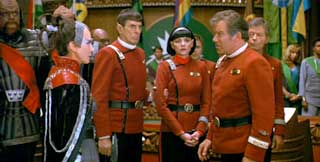 The Audio
The Audio

